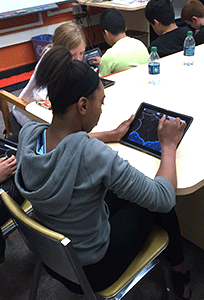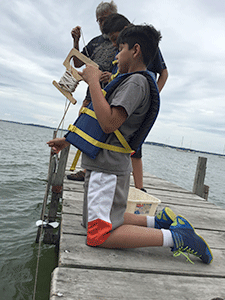This summer, students from the Boys and Girls Club of Dane County put on lab coats and worked as scientists recruited by the Centers for Disease Control (CDC).

The students played Virulent, an educational video game developed by Games+Learning+Society (GLS), and learned to think and act like scientists by role playing CDC scientists who were developing strategies to arrest the deadly Raven virus, the microbial infiltrator of the game.
“It was an introduction to biology,” says program coordinator Jennifer Dalsen, a doctoral student in the Department of Curriculum and Instruction. Dalsen says playing Virulent was a stepping stone for the students and proved to be an effective tool for teaching and learning. Virulent is a strategy game where players learn about virus replication, the immune system, and the process of viral infection. Each level of the game is a slide of a microscope. The game is played in conjunction with a curriculum in which students role play scientists who are recruited from the CDC to stop the virus from spreading across the globe.
“They start off saying things like ‘what is that triangle-ly thing?’ Or ‘this one looks like a hot dog,’” Dalsen says. “But by the end, they are using the scientific terms. They know what a virus is. They know what antibodies do. They understand what it means for a virus to mutate. Then they’re actually correcting each other. ‘Oh, wait, that’s not what it is. You’re not being a scientist. This is actually what it’s supposed to be.’ It’s amazing to see the transformation.”
Brianna Mueller, extended summer learning opportunities coordinator for the Boys and Girls Club of Dane County, says the program offered her students a valuable learning experience. “The students at the Boys and Girls Club may be more underrepresented and not have access to these kinds of resources,” she says. “It was so exciting to see them have access, excel at using these resources and to find things that empowered them.”
“By the end, they are using the scientific terms. They know what a virus is. They know what antibodies do. They understand what it means for a virus to mutate.” -Jennifer Dalsen
During the five-week summer program, the students also played Anatomy Browser and Econauts, other video games developed by GLS.
Anatomy Browser is a human anatomy catalog that allows players to see the layers of the body and identify muscles, organs, and systems of the body in three dimensions. On one day, the students navigated a small capsule through the whole GI tract, writing down their observations and learning to identify different key words en route. Then they created a model of the gastro-intestinal tract based upon what they discovered on their virtual journey.
Mueller says it was a wonderful learning opportunity for her Boys and Girls Club students to be on campus for five weeks.
“My students really got to be science experts,” she said. “It was very cool to see them expand their vocabulary and awareness. It was great intellectual growth for 10-to-14 year olds. We always worry about brain dump and loss of knowledge in the summer. I really feel the kids had an opportunity to grow.”
The group also played Econauts, an ecology game in which players develop a deeper understanding of the relationships between choices that humans make and their ecological consequences.
“We had them draw a map of the lake before they played Econauts and then again at the end. In every case, at the end, we saw more detail,” says Robert Bohanan, an outreach program manager at GLS, North Temperate Lakes LTER, and WISCIENCE.

Bohanan, who helped develop Econauts, was also impressed that the students talked about and developed in-game strategy that demonstrated concern for the environment even when the goal of the game was to make money.
In addition to playing Econauts, the students took samples from the lake and visited the Center for Limnology where they were able to view water samples under real microscopes.
“I don’t recall that we had to give them much instruction on how to use a microscope. I’m guessing that was a translation from using the digi-scope in Virulent,” Bohanan says.
Dalsen also thinks that the different games reinforced each other.
In Virulent, for example, the students began to understand the microscopic virus. The facilitators were able to connect the knowledge gained during week one when the students played Virulent, with the lessons the following week when they played Anatomy Browser, which focused on the body as a whole.
“You connect the two together saying, what do you remember from last week?” says Dalsen. “‘What does the virus do, and how could that affect the body on a larger scale?’ you ask. Then you widen the lens a little bit with Econauts—that’s more about the environment. You ask: ‘How do you, as an individual, affect the world around you?’”
When the students viewed their samples from the lake under a microscope, Dalsen says she looped the discussion back to Virulent and Anatomy Browser by asking: ‘What are you seeing under the microscope? How does this relate back to Virulent? How does this affect what we are doing? How does it affect our body?’”
Bohanan says he was impressed by the helping behavior he saw. He says he often saw one student helping another student who was not familiar with iPad games or iPads in general. “Even in timed competitions, students were helping each other,” he says.
Mueller also saw her students assist others. “They turned out to be these great leaders who could help the people around them be successful in these games and learn more from playing them,” she says. “I saw some really cool leadership skills develop in those kids, and I even heard one of them say at the end, ‘I really love this. I would like to think about maybe someday designing video games myself.’ I think it opened the kids’ eyes to some things they had never really been immersed in before.”
Mueller and Dalsen hope that the partnership, which initially grew out of the 2015 Game-A-Palooza event, will continue, perhaps even as an after-school program during the regular school year.
“I really hope that we can do the partnership again next year because I think the participants learned a lot from these educational games,” Dalsen says. “We learned a lot from them too—about how kids think and how they interact with each other. That’s always a learning experience by itself. Educational games are such a powerful tool.”
–Mary Sussman


You must be logged in to post a comment.